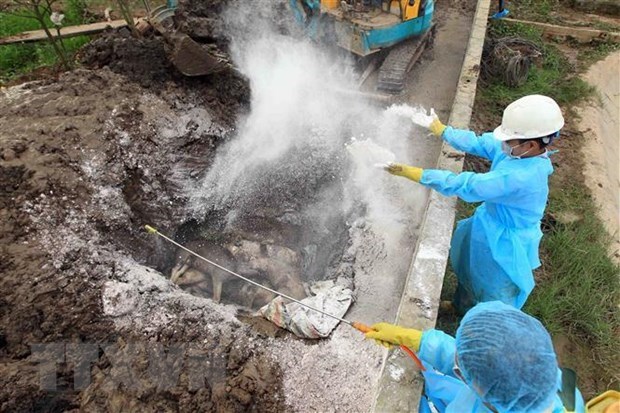 Opinion
Opinion

Nguyễn Xuân Dương, acting director general of the Husbandry Department under the Ministry of Agriculture and Rural Development, talks to Việt Nam News Agency on the animal husbandry sector’s efforts to handle the current outbreaks of diseases in livestock
What is the livestock breeding production situation in Việt Nam?
In the first quarter of 2019, the livestock breeding sector achieved a much higher growth rate compared to the same period last year. For example, cow herds saw an increase of 3 per cent while the total weight of live cows was reported to be more than 99,000 tonnes – an increase of 2.5 per cent compared to the same period in 2018. Meanwhile, the output of fresh cow milk reached almost 253,000 tonnes – an increase of 7.3 per cent.
The animal husbandry sector also showed progress in the period under review. By March 2019, the sector saw an increase of 6.5 per cent against the same period last year. Live pig weight was reported at more than 338,000 tonnes and poultry eggs were at about 3.6 billion – an increase of 10.6 per cent.
Despite the progress, pig raising was affected by the African swine fever outbreak. Pig herds, in March, still saw an increase of 2.5 percent compared with the same period last year while total live pig weight was reported at more than one million tonnes – an increase of 3.2 per cent.
However, the number of pig heads will drop in the upcoming third and fourth quarters due to the recent swine fever outbreak. As a result, there will be a shortage of pork.
However, the Department of Animal Husbandry has developed a plan to respond to the situation which includes the restructuring of the animal husbandry sector to focus on pig raising. We will delay efforts to develop this area until the outbreak of African swine fever comes to an end.
The sector has also developed a plan to raise the country’s animal husbandry and the rearing of beef cattle. It also has a plan to increase the output of the seafood sector.

|
| African Swine Fever (ASF) spread among 20 provinces and cities in Viet Nam in March with nearly 25,000 pigs culled in an attempt to stop the disease from reaching the southern farms. — VNA/VNS Photo |
What are the negative impacts of African swine fever on animal husbandry?
African swine fever is not dangerous to people as the disease is not transmitted to human beings.
However, 100 percent of pigs which are infected with the disease die. The disease spreads very quickly from sick pigs to healthy ones and we have not found any effective measures to cure or prevent the disease. We have no vaccine.
It is projected African swine fever will cost Việt Nam between VNĐ3 trillion and 3.5 trillion (US$130 million and $150 million).
Has the Department of Animal Health developed any measures to cope with the disease in the future?
African swine fever first appeared about a hundred years ago. By now, 59 countries have reported epidemics, and the main virus in such epidemics is the African virus.
In my opinion, until we can develop an effective vaccine, we should apply bio-safety measures. All big animal husbandry companies have by now applied bio-safety measures in their production, including preventive measures.
However, in Việt Nam we have faced a big challenge in asking households to take preventive measures. We have recommended to them that all animal husbandry areas be separated from residential areas. This is the most effective way to prevent contamination between human beings and affected animals.
In addition, all animals must have all required vaccinations and access to clean water.
Last but not least, farmers should only buy healthy young animals.
Related News:
Veterinary authorities on Monday detected African swine fever on a farm in Thua Thien-Hue Province after a few pigs were found dead there.
It is the 19th locality in Việt Nam to which the disease has spread and the first in the mid-central region.
A pig farm in Phong Son Commune, Phong Dien District, discovered three dead pigs last Saturday, and they were later confirmed to be infected with African swine fever, head of the local Veterinary Department, Nguyen Van Hung, said on Monday.
The dead animals were disposed of and all farms in the area were sanitised to contain the disease, he added.
Inspection stations have been set up on all roads leading to Phong Son Commune.
Despite having controlled the flow of cattle in and out of the province and the selling and butchering of pigs, the disease still found its way into Thua Thien Hue, Hung said.
"We suspect the virus might have come here via tourism since [the family that owns the infected farm] has a small shop for tourists to come in and rest,” said Hung.
Việt Nam is the third country in Asia to be hit by the disease after China and Mongolia.
African swine fever is a viral disease that infects all pig species through bodily fluids such as blood and mucus, causing hemorrhagic fever. There is currently no cure.
However, humans are not affected by the disease.
Twenty countries and territories have reported outbreaks of the disease since 2017 and more than one million pigs have been culled, according to the World Organization for Animal Health.
The disease first hit northern Việt Nam before spreading to nearby Nghe An and Thanh Hoa provinces. Ha Noi and the port city of Hai Phong are also affected. VNS




